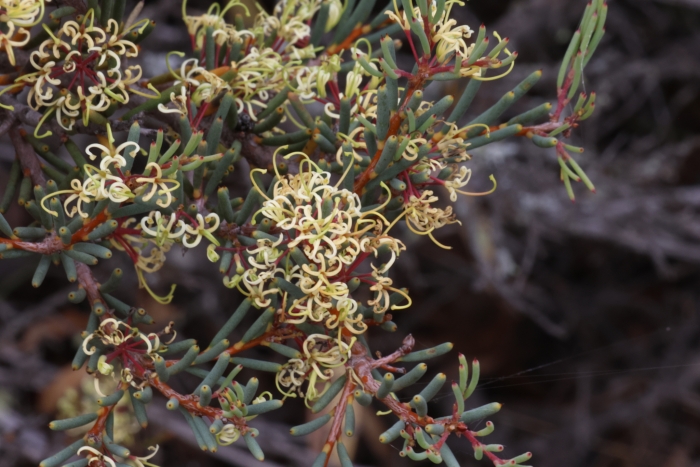Grasstree Hakea
(Hakea commutata)
Grasstree Hakea (Hakea commutata)
/
/

© Greg Tasney
CC BY-SA 4.0
Image By:
© Greg Tasney
Recorded By:
Copyright:
CC BY-SA 4.0
Copyright Notice:
Photo by: © Greg Tasney | License Type: CC BY-SA 4.0 | License URL: http://creativecommons.org/licenses/by-sa/4.0/ | Uploader: gregtasney | Publisher: iNaturalist |




















Estimated Native Range
Summary
Hakea commutata, commonly known as the Grasstree Hakea, is an evergreen shrub endemic to the southwest of Western Australia. It is typically found in mallee heath, sandy plains, and along creek lines within its native range. This species can vary greatly in size, ranging from 2 to 10 feet in height, with a similar spread. The leaves of Hakea commutata are needle-shaped, bluish-green with a distinctive whitish powdery covering that helps reflect sunlight and conserve water. From late winter to spring (September to November), it produces striking red-pink and cream-white flowers that are moderately showy and attract nectar-feeding birds. Following flowering, woody brown fruits develop, which contain black to dark brown seeds.
The Grasstree Hakea is valued for its unique foliage and colorful flowers, making it a suitable choice for xeriscaping and as an ornamental in dry gardens. It is also used for habitat restoration projects due to its adaptability to poor soils and its role in supporting native fauna. In cultivation, it prefers well-drained sandy-loam or clay soils and requires little to moderate watering once established, tolerating drought and coastal conditions. Full sun is ideal for optimal growth and flowering. While generally low-maintenance, it can be susceptible to root rot if overwatered or planted in poorly drained soils. There are no widely recognized cultivars of this species in the horticultural trade, and it is not known to be invasive when grown outside its native range.CC BY-SA 4.0
The Grasstree Hakea is valued for its unique foliage and colorful flowers, making it a suitable choice for xeriscaping and as an ornamental in dry gardens. It is also used for habitat restoration projects due to its adaptability to poor soils and its role in supporting native fauna. In cultivation, it prefers well-drained sandy-loam or clay soils and requires little to moderate watering once established, tolerating drought and coastal conditions. Full sun is ideal for optimal growth and flowering. While generally low-maintenance, it can be susceptible to root rot if overwatered or planted in poorly drained soils. There are no widely recognized cultivars of this species in the horticultural trade, and it is not known to be invasive when grown outside its native range.CC BY-SA 4.0
Plant Description
- Plant Type: Shrub
- Height: 10-20 feet
- Width: 6-12 feet
- Growth Rate: Moderate
- Flower Color: White
- Flowering Season: Winter
- Leaf Retention: Evergreen
Growth Requirements
- Sun: Full Sun
- Water: Low
- Drainage: Fast
Common Uses
Bird Garden, Drought Tolerant, Low Maintenance
Natural Habitat
Endemic to mallee heath, sandy plains, and along creek lines in the southwest of Western Australia
Other Names
Common Names:
Scientific Names: , Hakea commutata, Hakea nodosa,
GBIF Accepted Name: